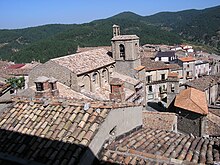San Giovanni in Fiore
| San Giovanni in Fiore | ||
|---|---|---|

|
|
|
| Country | Italy | |
| region | Calabria | |
| province | Cosenza (CS) | |
| Coordinates | 39 ° 16 ' N , 16 ° 42' E | |
| height | 1050 m slm | |
| surface | 279 km² | |
| Residents | 16,671 (Dec. 31, 2019) | |
| Population density | 60 inhabitants / km² | |
| Post Code | 87055 | |
| prefix | 0984 | |
| ISTAT number | 078119 | |
| Popular name | Sangiovannesi | |
| Patron saint | San Giovanni Battista | |
San Giovanni in Fiore is a place in the province of Cosenza in the Italian region of Calabria with 16,671 inhabitants (as of December 31, 2019).
San Giovanni in Fiore is 62 km east of Cosenza . The place, which lies in the wooded plateau and mountain region of the Sila to the left of the Neto River , is known as an agricultural center and for its artistic weaving. San Giovanni in Fiore had a train station on the former Pedace – San Giovanni in Fiore railway .
The neighboring communities are Aprigliano , Bocchigliero , Caccuri ( KR ), Casali del Manco , Castelsilano ( KR ), Cotronei ( KR ), Longobucco , Savelli ( KR ), Taverna ( CZ ).
history
The name and the origin of the place go back to Joachim von Fiore (Italian: Gioacchino da Fiore), who founded a monastery here at the end of the 12th century, around which the place developed. The abbey of the monastery now houses a museum that documents the history, the agricultural work methods and the traditions of the area.
In 1911 the Società italiana strade ferrate del Mediterraneo commissioned the project for a narrow-gauge railway line Cosenza- Crotone . In 1922 the first short piece went into operation. In 1931 the railway reached the culmination point Camigliatello Silano at 1272 meters above sea level. Construction only continued in 1949, and kilometer 67 was built in 1956, San Giovanni in Fiore Stazione , the provisional terminus. In 1997, rail operations were stopped again.
In the first half of the 20th century, the city's population rose from 16,000 to 18,000, one reason being the construction of two dams, Lake Arvo and Lake Ampollino, on the Sila plateau in the 1920s. After the Second World War, the population decreased again as many job seekers emigrated. At the same time, however, living space increased because many guest workers had built a house with the money they had earned abroad. In 2001 the city would have had capacity for around 60,000 residents. In 2001, 6,157 residents were registered as living abroad, 2,012 of them in Switzerland; 5,513 were registered as unemployed.
literature
- Georg Brunold: Building a House. You only meet returnees in Calabria, they were all in Switzerland. However, this does not mean that all emigrants will return. Journal du No. 722, Tamedia Zurich, December 2001 and January 2002, pages 42–55
Web links
Individual evidence
- ↑ Statistiche demografiche ISTAT. Monthly population statistics of the Istituto Nazionale di Statistica , as of December 31 of 2019.
- ^ Georg Brunold: Building a house. You only meet returnees in Calabria, they were all in Switzerland. However, this does not mean that all emigrants will return. Journal Du No. 722, Tamedia Zurich, December 2001 and January 2002, pages 42–50
- ^ Georg Brunold: Building a house. You only meet returnees in Calabria, they were all in Switzerland. However, this does not mean that all emigrants will return. Journal Du No. 722, Tamedia Zurich, December 2001 and January 2002, page 45
- ^ Georg Brunold: Building a house. You only meet returnees in Calabria, they were all in Switzerland. However, this does not mean that all emigrants will return. Journal Du No. 722, Tamedia Zurich, December 2001 and January 2002, pages 51–52


